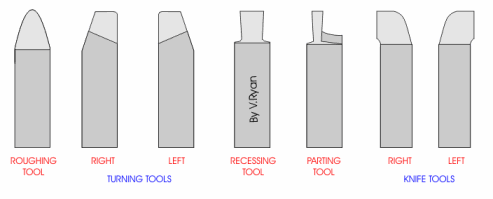THE CENTRE LATHE
The Centre Lathe is used to manufacture cylindrical shapes from a range of materials including; steels and plastics. Many of the components that go together to make an engine work have been manufactured using lathes. These may be lathes operated directly by people (manual lathes) or computer controlled lathes (CNC machines) that have been programmed to carry out a particular task. A basic manual centre lathe is shown below. This type of lathe is controlled by a person turning the various handles on the top slide and cross slide in order to make a product / part.
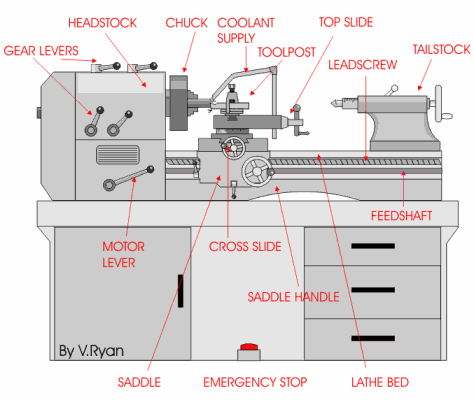
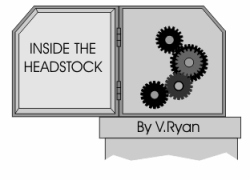 The headstock of a centre lathe can be opened, revealing an arrangement of gears. These gears are sometimes replaced to alter the speed of rotation of the chuck. The lathe must be switched off before opening, although the motor should automatically cut off if the door is opened while the machine is running (a safety feature).
The headstock of a centre lathe can be opened, revealing an arrangement of gears. These gears are sometimes replaced to alter the speed of rotation of the chuck. The lathe must be switched off before opening, although the motor should automatically cut off if the door is opened while the machine is running (a safety feature).The speed of rotation of the chuck is usually set by using the gear levers. These are usually on top of the headstock or along the front and allow for a wide range of speeds.
However, sometimes the only way to set the lathe to a particular speed is to change the gear arrangement inside the headstock. Most machines will have a number of alterative gear wheels for this purpose
THE CENTRE LATHE
- 'FACING OFF'
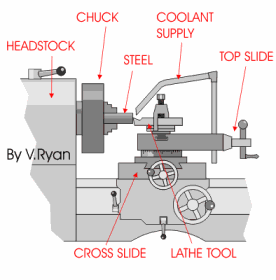
A very basic operation is called ‘facing off’. A piece of steel has been
placed in the chuck and the lathe cutting tool is used to
level the end. This is done by turning the cross-slide handle so that
the cross-slide moves and the cutting tool cuts the surface
of the steel.
Only a small amount of material should be removed - each pass of the cross slide. After each pass of the cutting tool the top slide can be rotated clockwise to move the tool forward approximately 1mm. This sequence is repeated until the steel has been levelled (faced off).
When using a centre lathe it is always advisable to work patiently and safely. Do not attempt to removed too much material in one go. At best this will caused damage to the steel being worked on and to the expensive cutting tool being used. At worse an accident will occur.
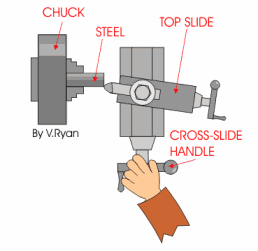
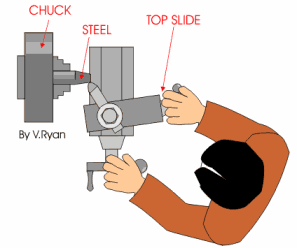
TURNING A SHORT TAPER When turning a short taper the topslide is set a the required angle. This is normally done by loosening two small allen screws and then rotating the topslide to the angle and tightening back up the two allen screws.
When the chuck is rotating the topslide handle can be rotated slowly by hand in a clockwise direction. A small amount of metal is removed each time until the taper is formed. If too much steels stands out from the chuck the steel will vibrate and the surface finish will be very poor.
HOW TO CENTRE THE CUTTING TOOL
V. Ryan © 2003
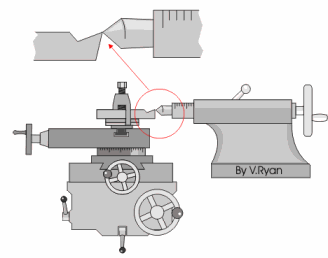
Before any turning takes place it is common practice to check that the point of the lathe tool is centred. This means that the lathe tool point should be the same height as the tip of the tailstock centre. If this is not done and the tool point is either above or below the centre point - usually the finish to the steel will be poor. Also, a significant amount of vibration could take place during turning.
The best lathe cutting tools are made from high speed steel. Diagram ‘A’ shows a typical solid lathe tool. The shank is clearly shown, this is the part that is fixed into the toolpost. Diagram ‘B’ shows a second type. This is a tool holder. A small lathe tool made of high speed steel is tightened into the cast steel tool holder. The advantage of this type is that the smaller lathe tools are cheaper to buy.
TWO TYPES OF LATHE CUTTING TOOLS
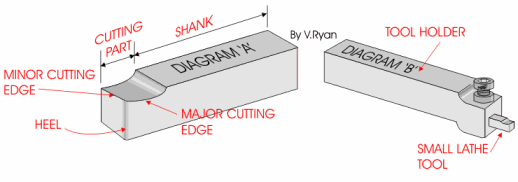
A SELECTION OF LATHE CUTTING TOOL PROFILES
